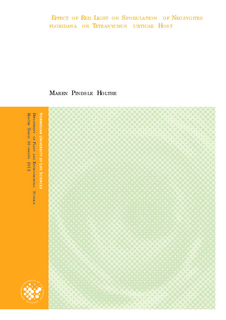| dc.contributor.author | Holthe, Maren Pindsle | |
| dc.date.accessioned | 2012-06-22T07:44:53Z | |
| dc.date.available | 2012-06-22T07:44:53Z | |
| dc.date.issued | 2012-06-22 | |
| dc.identifier.uri | http://hdl.handle.net/11250/189411 | |
| dc.description.abstract | The mite pathogenic fungi Neozygites floridana is an important natural enemy to the polyphagus
two-spotted spider mite Tetranychus urticae. In order to increase the efficacy of N. floridana in
conservational biological control, two experiments on how direct and indirect light (light:dark ratio, intensity/quantity and quality) affects sporulation of N. floridana on cadavers from its natural host T. urticae were conducted. Controlled climatic chambers gave the same ambient conditions of 20 ºC and 70 % RH. Two light regimes were used and went as follows: 12 h HPS 150 μmol m-2 s-1 for both treatments, 4h of Red LED 50 μmol m-2 s-1 for the red light treatment and parallel 4 h of white HPS 50 μmol m-2 s-1 for white light treatment. Both treatments had darkness for the proceeding 8 h. Indirect light effect was studied by placing two strawberry plants with 90 N. floridana infected T. urticae on each plant in light emitting tunnels with a 24 h spore catcher
in each light treatment. The freshly killed cadavers were left to sporulate during the 8 days of the experiment with the tape on the spore catcher changed every 24 h. The difference between N. floridana spores discharged in red and white light treatment proved to be time dependent (P=0.00). Spore discharge started during the hours of red light treatment and continued through
the dark hours while under white light spore discharge did not start until the dark hours. It is difficult to say if the total number of spores discharged was affected by the different light regimes (P=0.00) as the total number of spores discharged in the white regime varied considerably between the tunnels. The effect of 24 h direct light exposure from the two light treatments on N. floridana killed T. urticae cadavers mounted on a coverslip with grid was not significantly different (P=0.256). The total number of spores discharged varied considerably within each light
treatment, resulting in large standard deviations. As the results from the indirect light experiment show, the prolonged sporulation under red light could increase the performance of N. floridana in biological control of T. urticae populations. | no_NO |
| dc.language.iso | eng | no_NO |
| dc.publisher | Norwegian University of Life Sciences, Ås | |
| dc.subject | agroecology | no_NO |
| dc.subject | pathogenic fungi | no_NO |
| dc.subject | Tetranychus urticae | no_NO |
| dc.subject | biological control | no_NO |
| dc.subject | artificial light | no_NO |
| dc.subject | lighting | no_NO |
| dc.subject | strawberry | no_NO |
| dc.title | Effect of red light on sporulation of neozygites floridana on tetranychus urticae host | no_NO |
| dc.type | Master thesis | no_NO |
| dc.subject.nsi | VDP::Agriculture and fishery disciplines: 900::Agriculture disciplines: 910::Plant breeding, horticulture, plant protection, plant pathology: 911 | no_NO |
| dc.source.pagenumber | 43 | no_NO |
